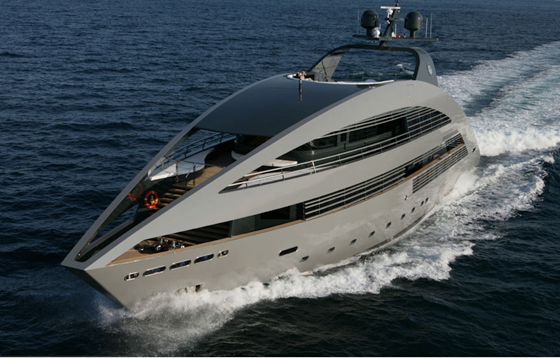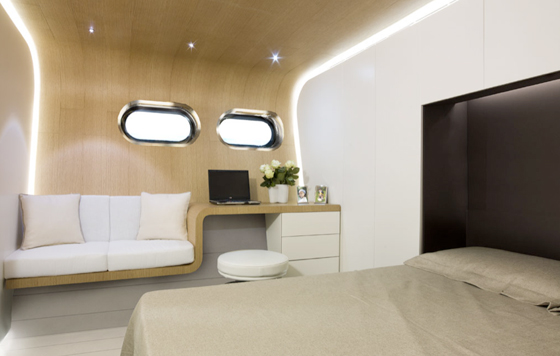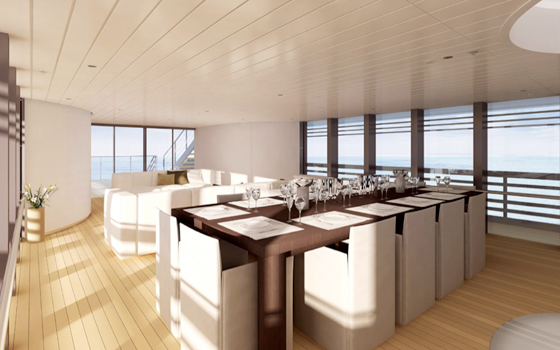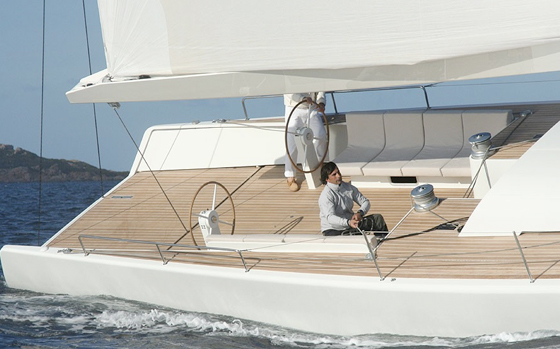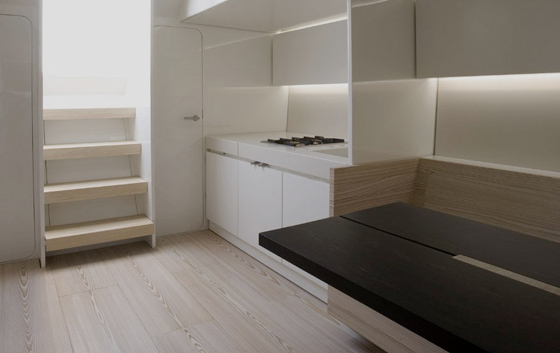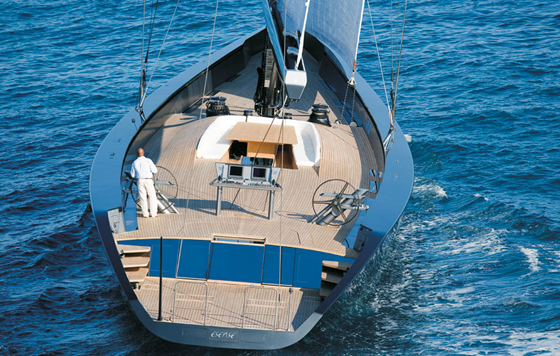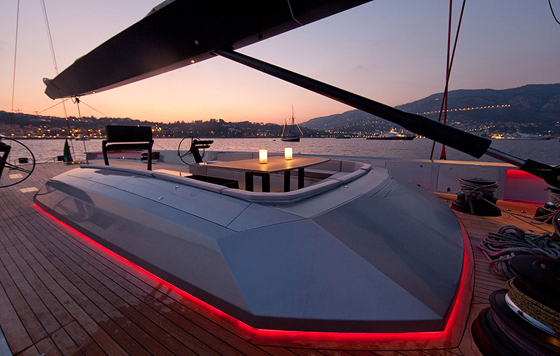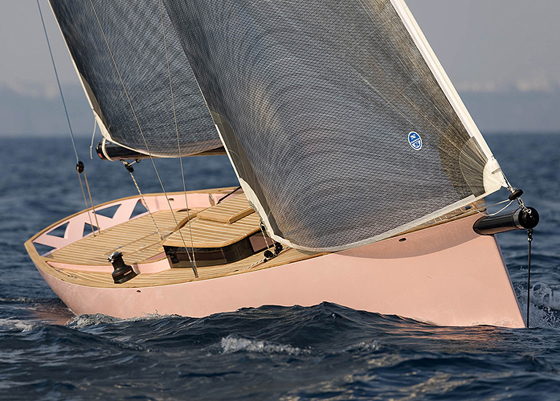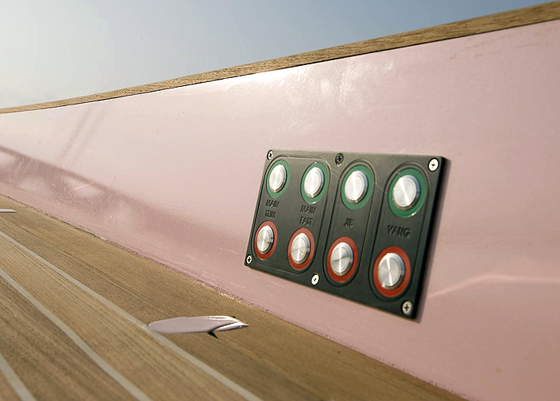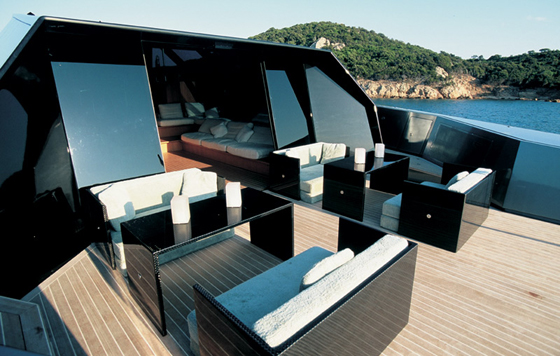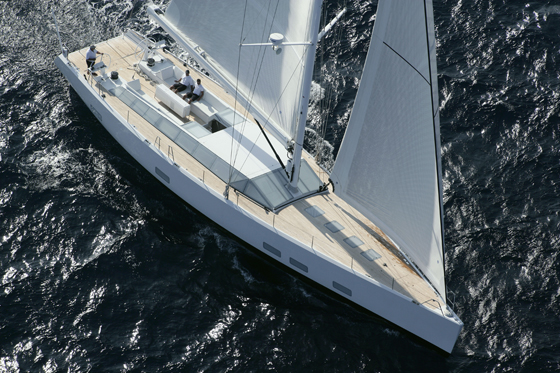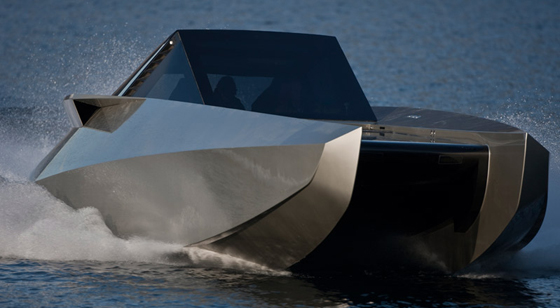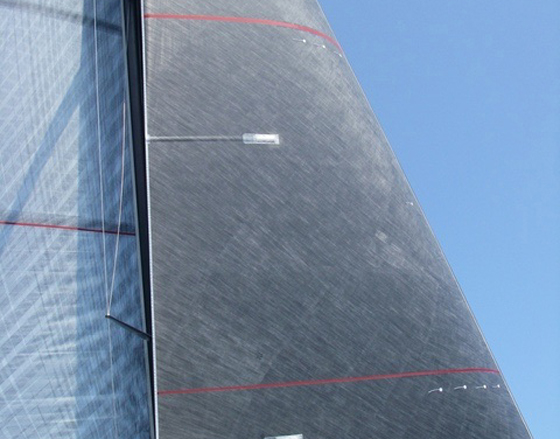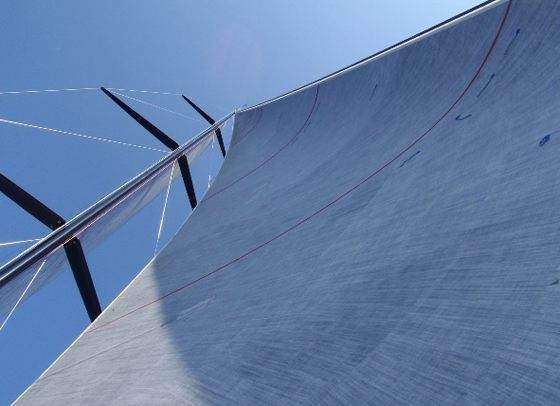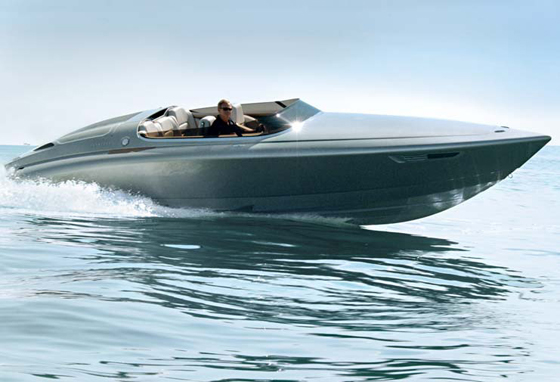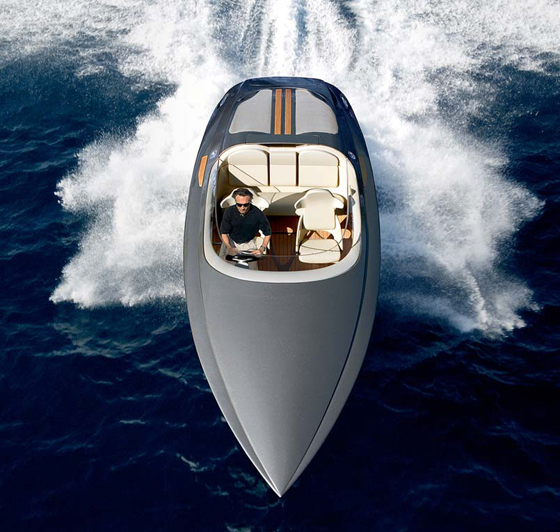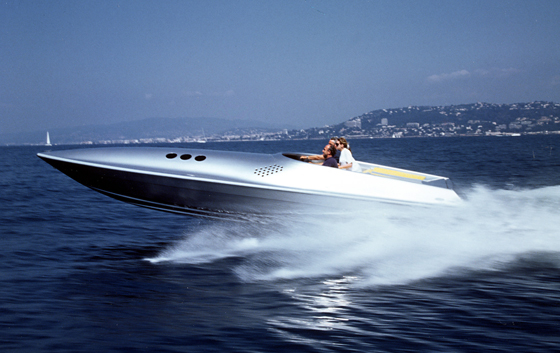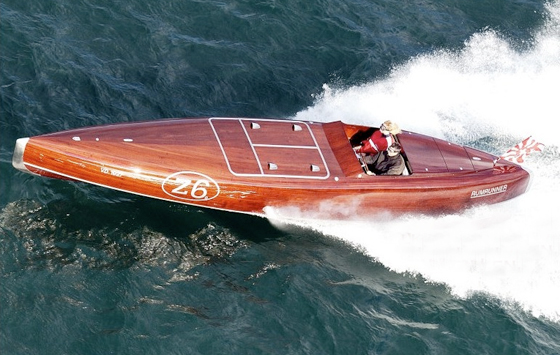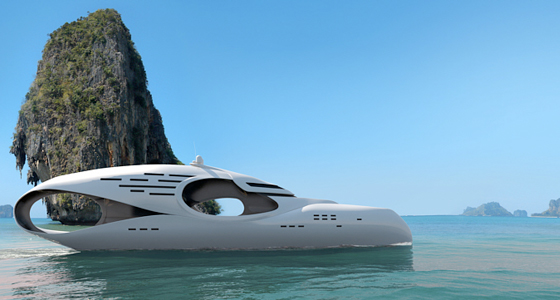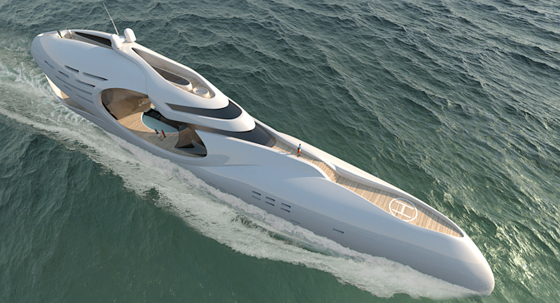Yachting – Design
Texte par Susanne Fritz
Suisse
30.04.10
Modern design, beyond teak and brass fittings, has, however, been around for a long time in the world of yachting. Innovative boat-builders and designers work with new propulsion technology, materials and formal languages.Yachts are perfect for this kind of experimentation: often commissioned and completed as a prototype, they lend themselves to new developments and are at the same time one of the last bastions of bespoke handwork.
The 'glamour' of yachting is made up of several factors: space, money and scarcity. The number of registrations is limited and moorings are hard to get and are expensive. And the maintenance of a boat requires cash, time and staff. Moreover, getting your captain's licence involves a time-intensive training and a difficult test, and boats from a certain size onwards can only be steered with several people on board: basically, you need a crew.
Motor yacht der '40 Signature Series', photo © Yacht Plus
The layout and the interior construction of yachts demands experience and significant architectural skill, since with boats it's about optimising space and carefully considering the particular proportions of the hull. Sea-going, damp and the air's salt content require specific solutions as regards build and materials. Boat-builders and engineers have the technical know-how, but draw on designers and architects during the planning stage. Two of today's highest-profile contemporary architects have even worked on yachting projects.
Interior of '40 Signature Series' motor yacht, design Sir Norman Foster, photo © Yacht Plus
Sir Norman Foster has designed the motorcruiser '40 Signature Series' for the British company 'Yacht Plus'. The firm offers an innovative concept, with an all-round service for an exclusive clientele, which nonetheless has certain cost limits. Instead of buying or chartering the boat, the client can avail themselves of an always-manned and maintained craft from a wider fleet. The design is also innovative. Hull and superstructure are made of aluminium. The material gives the boat a metallic, futuristic look.
Interior of '40 Signature Series' motor yacht, design Sir Norman Foster, photo © Yacht Plus
Inside, the focus is on the light and the numerous views – things that classic boat-building doesn't often address, as the body of the craft only offers a limited number of openings. Foster solved this cleverly by linking the four decks with a glass spiral staircase, whose opening brings light into the ships interior. Full-height windows and highly reflective, shiny materials maximise the available natural light. The limited amount of space on board makes privacy all the more important, should the boat be used for holidays or even for longer-term habitation. The 53-square-metre 'Owner's Suite' offers 'his and her' balconies, so that 'he' and 'she' don't get on each other's nerves too quickly.
'B60 Sloop', design: John Pawson/Luca Brenta Yacht Design, photo © Luca Brenta Yacht Design
John Pawson's light-filled, white interiors, together with wood-planked floors, create the refined, minimalist look of Luca Brenta Yacht Design's B-Series. Pawson has designed the inside of Luca Brenta's Yacht B60 Sloop, which features a carbon hull and the highest level of manoeuvrability. It's very much conceived, however, for leisure-cruising and racing: three spacious cockpits, finished in simple Pawson elegance and refined surfaces, make on-board stays homely. Luca Brenta, who revolutionised the day-cruiser/yachting scene for the Monaco firm Wally, looks after the technical details.
If electrically powered sailing at the touch of the button has become the standard of late, Brenta offers a new set of wow factors. The lowering of the anchor uses technology transferred from jetliner undercarriages. While very serious sailors will consider this mere bells and whistles, the captain of the B60 at least doesn't have to get his hands wet.
'B60 Sloop', design: John Pawson/Luca Brenta Yacht Design, photo © Luca Brenta Yacht Design
'Wally 143 Esense’ is at 43-metre-long megayacht designed by Wally, whose high performance is thanks to a Prepreg composite construction (Prepreg being a carbon fabric, preimpregnated with a special resin). The yacht weighs, due to its light construction, a 'mere' 140 tonnes.
The 40-metre Wally 130 is the result of a collaboration between Wally and Javier Soto Acebal Naval Architects. The cabin structure and the monitors for the controls are backlit with red LEDs, which not only looks cool and futuristic, but also reduces glare.
Wallynano is a new sporty day-cruiser, which, thanks to its detailed technology, can only be piloted by one person. Also small but perfectly formed is the 11.3-metre-long sailing yacht (which still isn't in any way 'nano') fits with the brand's minimal, graphic approach to boat design.
Wallynano's modern control of the sails at the touch of a button, photo © Wally
Wally is, however, also known for building motor sports boats, which, in the cool stakes, can hardly be outdone. 'Wallypower' motor yachts are strongly angular in appearance, an aesthetic that seems to be taken from the highly geometric form of stealth aircraft. These 'stealth bombers’ don't show up on the radar screen.
,Wallypower 118' by Wally, design: Wally / Lazzarini Pickering Architetti, photo © Wally
Lazzarini Pickering Architetti from Milan, an architectural practice with a particular flair for luxurious interiors, were heavily involved in the design of Wally's specially bespoke yachts. Carl Pickering and Claudio Lazzarini are established names in the yacht sector, and collaborate with boat-builders. Polytropon II, a sailboat, is one of the craft to come about in this way; it wasn't meeting the needs of its owner anymore, so a redesign was commissioned from Lazzarini Pickering. This moved the crew's sleeping quarters and the galley onto a separate boat, which can also be used to bring people to and from the main craft. Thus the yacht is reserved solely for the owner and his or her guests, and offers more space since the service areas have been removed.
,Polytropon II', design: Lazzarini Pickering architetti, photo © Lazzarini Pickering architetti
Interior of ,Polytropon II', design: Lazzarini Pickering architetti, photo © Lazzarini Pickering architetti

Interior of ,Polytropon II', design: Lazzarini Pickering architetti, photo © Lazzarini Pickering architetti
×Formally similar are the yachts made by Code X, based in Weggen near Luzern. Code X places an emphasis not only on a futuristic aesthetic, but also on future-oriented propulsion technology: first-generation Code-X boats marry conventional technology with renewable energy in the form of solar-hybrid drive. The second-generation Code-X yacht replaces conventional propulsion with a renewable, CO2-neutral ‘silicone fire fuel’ (made up of renewable energy, water and carbon dioxide), together with solar energy.
The high-end regatta scene develops the latest materials and technologies, which are then often adopted by amateur regatta yachtsmen and owners of luxury cruisers. Traditional sails feature countless stitches; the new 3DL sails by market leader North Sails don’t, in contrast, have any seams, consisting of a single, three-dimensional element. Carbon threads are applied over a framework; where more strength is required, more threads are applied. The result is a highly aesthetic structure.
Even more advanced is the new generation of 3DI sails. Filaments (a filament being a continuous fibre; chemical fibres can, as opposed to natural ones, be spun to be as long as you like, in theory at least) are brought together in parallel on a three-dimensional form using a type of plotter and thermally bonded. A membrane, as is the case with the 3DL sails, is no longer necessary. The result is an opaque, metallic-looking sail, which has the character of a rigid frame, rather than a textile fabric, but one that can still be rolled up.
It’s hard to think of motors and lifestyle without thinking of Porsche Design. As early as 1987, the Porsche Design Studio in Zell am See, Austria, produced the ‘Kineo’ motor yacht. ‘Kineo' is an exclusive racing boat, of which there are only three in the world and whose dolphin-like form brought it much attention. Together with the American boatyard ‘Fearless Yachts’, Porsche have created elegant speed boats. The ‘Aqua-Porsche’ can travel at up to 150 kilometres per hour – fearless indeed if you’re not wearing a seatbelt.
Kineo speedboat by Porsche Design Studio, photo © Porsche
The latest project from Porsche in the nautical sector involves motor catamarans – the ‘Royal Falcon Fleet’. The yachts in this series have huge dimensions for private craft. They are longer than 40 metres and can accommodate more than 20 people. The classical elegance of the Fearless motor yachts however isn’t in evidence here. But the motor catamaran RFF135, in contrast to megayachts of the same size, focuses not on interior opulence, but rather on functionality. Any luxury is self-evident.
Classical elegance on the water: wooden boats still exude an air of the 1960s French Riviera. Switzerland, a country full of lakes, as well as superior craftsmanship and understated chic, is home to several boatyards, which produce that 50s and 60s Rivera feeling. The 'Rum-Runner' by Swiss company Naval Design GmbH (Christian Bolinger & Oliver Simmonds), for example, glides through the water like an arrow thanks to its cigar-like form and its 370 horsepower.
Steeped in tradition, the Pedrazzini boatyard, located on Lake Zurich, has been building wooden boats for three generations. In the 1950s, the ‘Capri Super Deluxe’ was produced to Ferruccio Pedrazzini’s plans; it was the runabout that lends today’s Pedrazzini motor boats their characteristic, classic form.
Expensive woods, such as oak and mahogany, are laminated by hand onto the body of the boat in a costly process. The resulting wooden constructions are extremely strong and durable. The amount of handwork that’s involved in building such a boat becomes apparent in the number of hours that are invested in such labour: 1,800 to 4,000 hours or six to nine months of a worker’s time are required to build a single runabout.
Less suitable – if only because of its size – for the Swiss lakes are Schopfer Yacht Design’s boats. Working with Sparkman Stephens Naval Architects, Kevin E Schopfer designed a super-yacht called ‘Infinitas’, whose name takes a cue from the interwoven loop of the deck's superstructure. Interesting, spacious connections are created through the interior hollows of the yacht, whose particular shape provide the spaces with lots of light. Swimming pools, several separate decks and a helipad are just some of the amenities that the future owner of the ‘Infinitas’, which, as yet, only exists on the drawing board.
Schopfer Yacht Infineo, Rendering © Schopfer Yachts
Schopfer Yacht Infineo, Rendering © Schopfer Yachts
It’s no wonder that sailing brands have appeared on the world’s shopping streets and in its malls over the last few years. Paul Shark, Helly Hansen, Musto – the outfitters to the professionals convey some of the high value of this innovative and, at the same time tradition-steeped, sport, which resides in harbours throughout the world. Should you, having read this article, want to acquire your own yacht, a small, fashionable accessory is perhaps the first step on board your own boat.
Finally, the latest development: a collaboration between the French fashion house Hermès und the aforementioned company Wally. In Ancona, Italy, a 1:1 scale model of the WHY Yacht has been developed for around 150 million Euros, which looks more like a swimming island than a ship. This is no accident: oil-platform technology was used. Parking it, however, in the chic luxury marinas of this world, such as Marbella, St Tropez and Capri, would prove difficult, as the WHY is too wide for standard yachting harbours. This new yachting typology requires a new harbour concept to be devised. Until then, it will no doubt find a spot next to some container ship in the cargo port.
